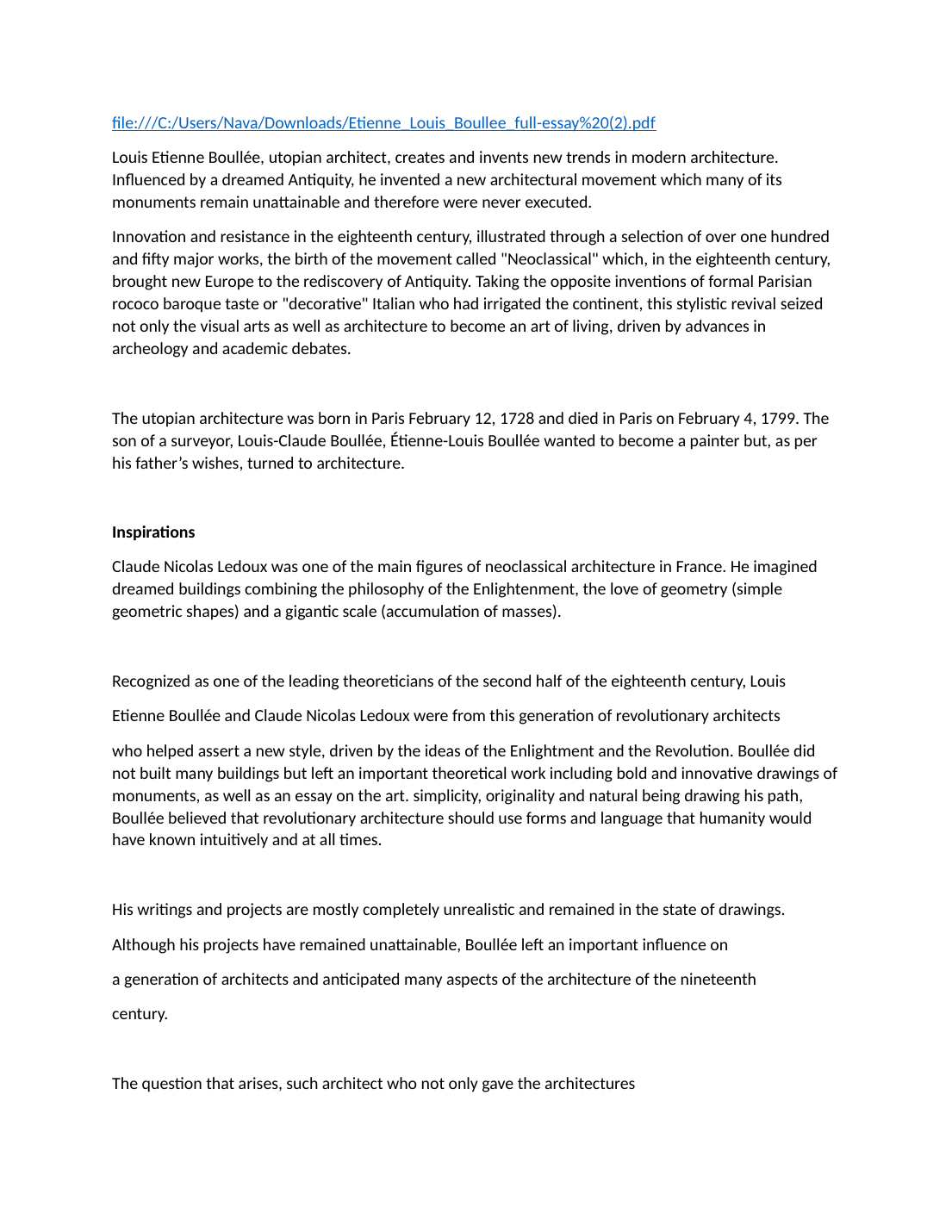Boullee, architecte futuriste
Publié le 23/05/2020

Extrait du document
«
file:///C:/Users/Nava/Downloads/Etienne_Louis_Boullee_full-essay%20(2).pdf
Louis Etienne Boullée, utopian architect, creates and invents new trends in modern architecture.
Influenced by a dreamed Antiquity, he invented a new architectural movement which many of its
monuments remain unattainable and therefore were never executed.
Innovation and resistance in the eighteenth century, illustrated through a selection of over one hundred
and fifty major works, the birth of the movement called "Neoclassical" which, in the eighteenth century,
brought new Europe to the rediscovery of Antiquity.
Taking the opposite inventions of formal Parisian
rococo baroque taste or "decorative" Italian who had irrigated the continent, this stylistic revival seized
not only the visual arts as well as architecture to become an art of living, driven by advances in
archeology and academic debates.
The utopian architecture was born in Paris February 12, 1728 and died in Paris on February 4, 1799.
The
son of a surveyor, Louis-Claude Boullée, Étienne-Louis Boullée wanted to become a painter but, as per
his father ’s wishes, turned to architecture.
Inspirations
Claude Nicolas Ledoux was one of the main figures of neoclassical architecture in France.
He imagined
dreamed buildings combining the philosophy of the Enlightenment, the love of geometry (simple
geometric shapes) and a gigantic scale (accumulation of masses).
Recognized as one of the leading theoreticians of the second half of the eighteenth century, Louis
Etienne Boullée and Claude Nicolas Ledoux were from this generation of revolutionary architects
who helped assert a new style, driven by the ideas of the Enlightment and the Revolution.
Boullée did
not built many buildings but left an important theoretical work including bold and innovative drawings of
monuments, as well as an essay on the art.
simplicity, originality and natural being drawing his path,
Boullée believed that revolutionary architecture should use forms and language that humanity would
have known intuitively and at all times.
His writings and projects are mostly completely unrealistic and remained in the state of drawings.
Although his projects have remained unattainable, Boullée left an important influence on
a generation of architects and anticipated many aspects of the architecture of the nineteenth
century.
The question that arises, such architect who not only gave the architectures.
»
↓↓↓ APERÇU DU DOCUMENT ↓↓↓
Liens utiles
- Dans son roman, Les Belles Images, Simone de Beauvoir oppose deux personnes, parlant de leur métier d'architecte : « Vergne a des idées formidables... c'est passionnant de travailler avec lui : tout l'atelier vit dans l'enthousiasme; on n'exécute pas, on crée. - Je préfère tout de même être chez Monnod, dit Dufrêne. On ne crée pas, on exécute. Seulement, on gagne bien davantage. » Après avoir précise la nature du problème posé, vous exposerez les réflexions qu'il vous suggère, en vent
- architecte n.
- Du géomètre à l'Architecte
- A. de Musset écrivait, dans un article publié le 1er novembre 1838, dans la Revue des Deux Mondes, sous le titre De la tragédie, à propos de Mademoiselle Rachel : « Si les règles étaient des entraves inventées à plaisir pour augmenter la difficulté, mettre un auteur à la torture et l'obliger à des tours de force, ce serait une puérilité si sotte qu'il n'est guère probable que des esprits comme Sophocle, Euripide, Corneille s'y fussent prêtés. Les règles ne sont que le résultat des calc
- ANDROUET DU CERCEAU, Jacques(vers 1510-vers 1585)ArchitectePremier titre de Jacques Androuet du Cerceau : architecte de Marguerited'Angoulême, soeur de François Ier.


